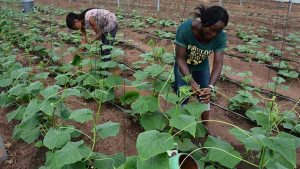Tanzania: Postharvest innovations key to raising youth involvement in horticulture
 17 Juni 2020
17 Juni 2020

Participation in horticulture gives Tanzanian youth income options within a short period
By External Source
Jun 16 2020 (IPS-Partners)
Horticulture is a field of agriculture that involves a short growing season averaging three months and offers quick yields and returns on investments despite the high rate of postharvest losses.
In Tanzania, with the Government-initiated National Strategy for Youth Involvement in Agriculture (NYSIA) for 2016–2021, horticulture is one viable option that would give Tanzanian youth income within a short period. Operated through the Ministry of Agriculture, the vision of the scheme is to empower youth to participate fully in agricultural development, contribute to economic growth, and address the challenge of unemployment.
Horticulture offers employment throughout each crop cycle, an aspect that is advantageous to youth employment, yet this field of agriculture records a high rate of losses. According to research, about 50 to 70% of horticultural output is lost during harvesting, handling, packaging, transporting, and marketing. Hence, postharvest management is critical to success in the horticulture sector.
Adella Ng’atigwa, a fellow of the Enhancing Capacity to Apply Research Evidence (CARE) in Policy for Youth Engagement in Agribusiness and Rural Economic Activities in Africa project, carried out a study on ways to empower youth to reduce horticulture postharvest losses in Tanzania. In the research, Ng’atigwa reveals that lowering the rate of postharvest loss for fresh produce would raise returns to young agripreneurs as well as increase food security in Tanzania.
Ng’atigwa conducted the study among youth in three of the six districts in the Njombe Region of the southern highlands of Tanzania. It reveals the stages at which losses occur, and some of the causes for crop loss that include poor storage facilities, weak transport systems, inadequate market location, poor handling, and inferior packaging materials.
Along with inadequate market location being a significant cause for postharvest losses in the Njombe Region, price fluctuations were cited as the most encountered problem facing young horticultural producers.
Based on the research findings, Ng’atigwa recommends staggered planting and harvest periods, timely harvesting, and ripening while warehoused, as ways to manage postharvest losses. Other recommendations include cold storage, solar drying, improved agronomic practices, more market places, and improved transport facility. Achieving these will raise returns and attract more youth to the horticulture industry in Tanzania.
Ng’atigwa added that there is a need to create incentives for the small and medium financial institutions and microcredit financial institutions in Njombe to provide loans with an affordable interest rate for youth. Such youth-friendly credit schemes will help them to access farm inputs and postharvest management (PHM) innovations.
With Africa striving towards achieving the Sustainable Development Goals (SDGs) and zero hunger, Tanzania’s move to improve horticulture, a sector that generates more than US$354 million per annum, is laudable. Addressing the challenge of postharvest losses would create a significant impact on the country’s economy and the livelihoods of youth investing their time and money in the sector.
Source: IITA News
The post Tanzania: Postharvest innovations key to raising youth involvement in horticulture appeared first on Inter Press Service.
